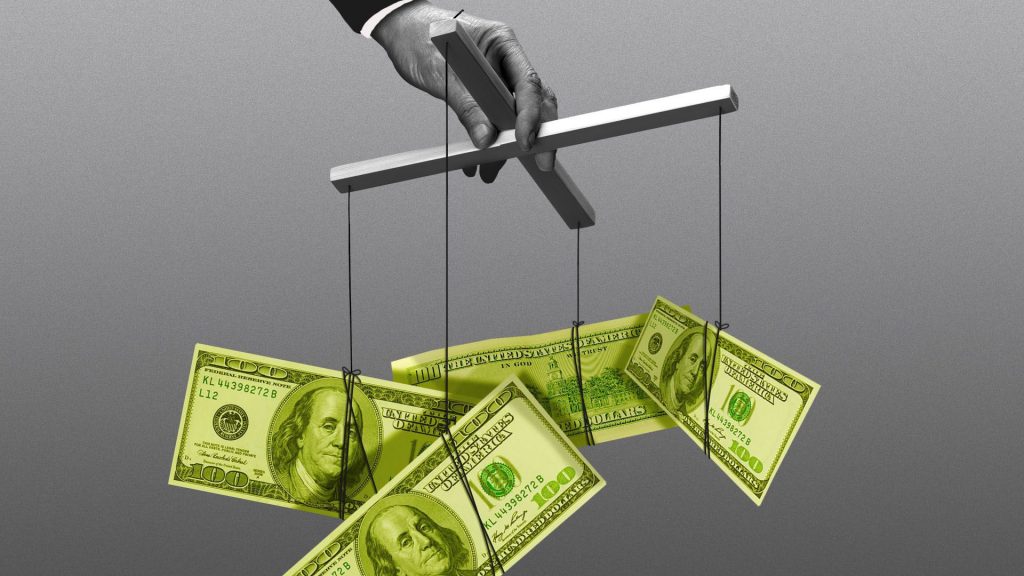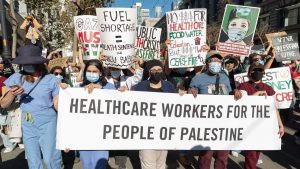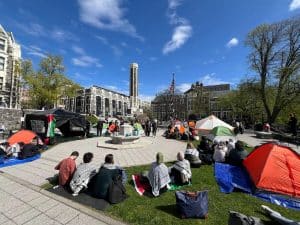Inflation in the United States is at a four-decade high — overall, there has been a roughly 6.8 percent hike in consumer prices since November 2020. The price hikes are particularly high for food — beef prices in November 2022 were up by 21 percent relative to the previous year, and the overall index for meat, poultry, fish, and eggs jumped 13 percent. Energy prices alone rose more than 33 percent in that same one-year period. As a result, inflation has become one of Americans’ top concerns. Despite its initial claims that inflation was temporary, the Federal Reserve — the U.S. central bank — and President Biden have begun to take measures to try to curb it, fearing that rising prices could spur social discontent.
The ruling-class “solutions” for curbing inflation, though, are all centered on maintaining capitalist stability and exploitation at the expense of the working class.
What Is the Fed Doing — and Why?
In its final meeting of 2021, the Federal Open Market Committee (FOMC) — which advises the Fed — decided to address the rise in inflation that has been starting to rack the U.S. economy. Essentially, the FOMC set a course for early elimination of the emergency “quantitative easing” program that the Fed undertook during the pandemic. Quantitative easing involves injecting money into the economy, which the Fed did by buying lots of securities, to encourage lending (at low interest rates) and investment, and thus stimulate economic growth. With that over, the Fed will increase the federal funds rate in 2022, likely two or three times, which means higher interest rates for everyone.
Higher interest rates affect workers in several ways, the most important here being that it becomes more expensive to spend money. In other words, borrowing to purchase a home or car — or any big purchase — costs more because the interest is greater. More generally, higher interest rates mean consumers have less disposable income and have to cut back on spending — and there’s no discrimination with respect to what they have to cut back on. For many, it could be basic necessities. Higher interest rates also mean it costs more for governments to borrow, which typically results in the imposition of austerity measures that are always directed at the working class and the most economically marginalized in capitalist society. Historically, higher interest rates have also kept U.S. companies from expanding employment.
Today’s inflation is expressed in prices that have risen because of increases in production costs, which include not only all the supply chain problems that have dominated the news for months but also increases in the costs of raw materials — and wages. The Biden administration is also concerned: presidents vying for reelection who have presided over inflation don’t typically win second terms, and the current inflation rates could have the nearer-term consequence of sinking the Democrats in the 2022 midterms.
Simple math tells us that if wages don’t rise along with prices, the cost of living goes up and living standards go down — which affects how people vote. There is, though, a more complex story.
On December 15, Fed chairman Jerome Powell held a press conference after the FOMC meeting to discuss why the committee had taken its particular decisions. Discussing the “drivers of higher inflation,” he referred to “dislocations caused by the pandemic” and “price increases [that] have now spread to a broader range of goods and services.” Notably, he did not specifically attribute inflation to wage growth; quite the contrary, it would seem. But let’s parse his words.
Wages have also risen briskly, but thus far, wage growth has not been a major contributor to the elevated levels of inflation. We are attentive to the risks that persistent real wage growth in excess of productivity could put upward pressure on inflation.
To her credit, reporter Jeanna Smialek of the New York Times questioned Powell about his “recent pivot toward greater wariness around inflation” — the chairman had quite famously said most of this year that there was nothing to worry about — and somehow that question let the cat out of the bag. He began to speak about a “very high” Employment Compensation Index (ECI) in November — 5.7 percent.
The ECI is a quarterly economic statistic published by the U.S. Bureau of Labor Statistics that details the growth of total employee compensation. It tracks movement in the cost of labor as measured by wages and benefits, at all levels of a company. When it’s going up, it’s a sign that workers are getting better wages and benefits. Bourgeois economists consider it a sign that inflation may be on the horizon when the ECI has a steepening trend line or it increases much more than expected in a given period, precisely because wages are the most significant cost for most companies to produce a product or deliver a service.
Powell’s response to the Times reporter revealed that every forecast these bourgeois economists had made was wrong. They were counting on the rising wages, which began before that reported quarter, to be a transitory phenomenon. They didn’t think that cutting off extended unemployment benefits and stimulus checks would have the opposite effect. Workers, instead of flocking back to low-paying, hyperexploitative jobs, quit or demanded more money and better working conditions. Instead of relieving the inflationary pressures that the modest wage gains had sparked, they extended the “Great Resignation” and Striketober to the end of the year — and probably beyond.
The Fed’s Main Worry: A “Wage-Price Spiral”
The Fed worries that if inflation isn’t checked, it could become a tool in the arsenal of workers agitating for further wage increases. The problem the Fed is confronting is that as the bosses pay workers more to stay on the job, they’ll likely find a way to pass on their higher costs to consumers. From capitalism’s perspective, that runs the risk of wages and prices steadily pushing each other upward — a phenomenon coined the “wage-price spiral,” which was behind the sustained high inflation that began in the late 1960s and persisted into the early 1980s.
Indeed, workers who have returned to work have seized the opportunity to demand higher wages, and they’ve been getting them. The Federal Reserve Bank of Atlanta’s “Wage Growth Tracker” revealed that there was a 4.3 percent increase in November, up from 4.1 percent in October, and the highest reading since 2007. For workers who switched jobs, it was 5.2 percent in November, up from 5.1 percent in October.
But don’t be fooled by these numbers; workers have been losing ground for several decades in terms of wages. Real pay has decreased for nearly three-fourths of U.S. workers this year, with inflation eating into real wages — which puts the lie to every deeply anti-worker article in the bourgeois press that seeks to blame rising wages for inflation. The trend of workers losing ground continues, as inflation pours salt on the wound.
The central bank also worries, on behalf of its capitalist masters, about the effects of inflation on the poorest sectors of the working class. It’s one thing to have to curtail discretionary spending because prices go up, but for poor households, the inflation of prices for necessities cannot be avoided except by cutting back on things like food, housing, and gas. Being forced to cut back on the basics has a nasty habit of spurring social discontent, which capitalists will be desperate to squash.
In that context, the Fed’s coming 2022 rate hikes cannot be dismissed as abstract monetary policy. Capitalists and their institutions are interested in self-preservation and keeping profits flowing, not in measurably improving workers’ lives. They only throw crumbs to the working class or cede minor reforms to the extent that it helps quell class struggle or helps their politicians win elections, and inflation is often presented as being out of the government’s hands.
But this is absolutely not the case. Governments can intervene in the economy, and they have repeatedly done so when it’s politically expedient for them. Notably, U.S. history contains invaluable examples of workers demanding relief from the capitalists during times of inflation — demands that aren’t aimed at capitalist stability.
U.S. Workers Have Fought Inflation Before
Historian Dana Frank describes how, in February 1917 as the drumbeat for a U.S. entry into World War I was getting louder,
an independent working-class housewives’ movement erupted in … New York City [when] thousands of immigrant Jewish women burst into violent street protests against the high cost of living. They instituted a boycott on chicken, fish, and vegetables which shut down much of the city’s foodstuffs marketing for two weeks, riveting public attention on the food price issue and sending public officials scurrying to and fro in panic.
At the time New York City was the “great stronghold” of the Socialist Party, and party activists “seized the opportunity for agitational work” afforded by the uprising, organizing more cost-of-living protests “designed to direct the movement toward Socialist goals.” The protests continued for several weeks, and the boycotts expanded to the point where sales of chickens, fish, and many vegetables came to a near complete stop. With their profits cut into and then the prospect of having to discard huge amounts of food once it rotted, wholesalers responded by cutting their rates “sharply.” Lower prices at the markets was a victory won by the action of these working-class women.
A half century later, the “housewife revolt” of 1966 again saw women — first in Denver and then in a number of other cities across the country — bringing their children to picket lines outside grocery stores, protesting the increasing cost of living. Rising food costs in particular spurred many to action over the ensuing decade. In 1973 soaring meat prices sparked a consumer boycott, and the government tried a price freeze once again — while George Shultz, the Treasury secretary, urged women to try “shopping wisely.” But the freeze didn’t work, precisely because they depended on all the “actors” in the market to continue functioning as before except that the prices would be lower by force. So, instead of abiding by price controls, “ranchers stopped shipping their cattle to the market, farmers drowned their chickens, and consumers emptied the shelves of supermarkets.”1Daniel Yergin and Joseph Stanislaw, The Commanding Heights: The Battle for the World Economy (New York: Simon and Schuster, 2002). Meat prices rose 37 percent that year, another 22 percent in 1975, 24 percent in 1978, and 27 percent in 1979.
By then, Jimmy Carter was president, and he had a Council on Wage and Price Stability. Its director, Barry Bosworth, later called it “a complete failure.” That result was the outcome of only partial control of prices aimed at ensuring that some profit could still continue to accrue, rather than addressing the price problem as one of fulfilling human needs.
Perhaps the most stirring inflationary example in the United States was the so-called energy crisis of the 1970s — which was actually two crises. In 1973, the Yom Kippur War in the Middle East caused massive interruptions in the export of oil, largely because the Organization of Petroleum Exporting Countries (OPEC) raised the price of crude by 70 percent and initiated an embargo on sales to Israel’s funder, the United States. Home heating oil prices surged, business costs skyrocketed (and were passed on to consumers), and gas for cars had to be rationed. There were lines of cars as long as five miles waiting to buy limited amounts from gas stations.
In response, on December 3, 1973, a long-haul trucker carrying meat from the Midwest to New York City stopped his rig in the middle of Interstate 80 in Blakeslee, Pennsylvania. The rationing had forced him to stop at almost every gas station along his route, and he was fed up.
That trucker, J. W. Edwards, got on his citizen band radio and announced he was blocking the interstate to protest the high gas prices, limited fuel supply, and a proposal to lower the speed limit that the federal government had introduced. Within an hour, there were hundreds of rigs stopped on I-80, causing a traffic jam of more than 1,000 vehicles extending 12 miles in both directions. By the next day, highways in 10 states were similarly shut down by trucker protests.
The year 1973 also saw some large marches. A large multiracial group of senior citizens in Chicago mobilized that October, marching through the city with signs demanding full employment, a halt to inflation and high prices, and to “tax the rich, not the poor.”
The movement lasted into 1974, when the oil crisis began to abate. But five years later, there was a new shock: the 1979 Iranian Revolution. The gas lines returned. Amid panic buying and rationing, many parts of the country saw consumers rioting at gas stations and attacking police who were working details to keep the lines moving.
While obviously none of these protests rescued the working class from the repeated cycles of boom and bust, inflationary spirals, and recessions that capitalism imposes on the exploited working class repeatedly, they did win some price relief in the immediate term, and even some longer-term reforms. Labor historian Emily E. LB. Twarog’s book Politics of the Pantry spells out how “citizen housewives” who defined the consumer-advocacy movement are largely responsible for many things we take for granted at supermarkets: meat visible through sealed, see-through plastic; clearly marked prices, instead of surprises at the checkout counter; expiration dates, and so on.
What’s to stop such a movement from confronting inflation today? The working class has unions that could take up the mantle, and the power to self-organize independently of any bureaucracies to wage a struggle — just as it has done throughout the history of the battle against high prices.
What Can the Working Class Demand Right Now?
In the Transitional Program, Leon Trotsky spelled out programmatic elements for the working class and its organizations, especially the trade unions, to confront the “two basic economic afflictions, in which is summarized the increasing absurdity of the capitalist system.” One of them is unemployment; the other is high prices. To combat inflation, he raised the demands for “employment and decent living conditions for all.” And Trotsky spelled out the specific demand to combat inflation, which at the time was largely a function of the run-up to World War II. Nevertheless, the demand is as relevant today.
Against a bounding rise in prices … one can fight only under the slogan of a sliding scale of wages. This means that collective agreements should assure an automatic rise in wages in relation to the increase in price of consumer goods.
So, one measure that could be taken today, immediately, would be automatic wage increases in line with inflation. Employers — if they raise wages at all — typically give wage increases on an annual or semiannual basis. Although prices have steadily been rising for several months, employers are currently considering wage raises to be implemented in 2022. In other words, workers see inflation eat into their pay for months before receiving raises, and these raises may not even match the rate of inflation. Workers need wages that increase automatically, in every paycheck, to keep up with inflation at a minimum. And workers need these increases to go beyond wages exclusively to also include automatic, equivalent increases to things such as food stamps, disability payments, healthcare benefits, and unemployment benefits.
Today’s bourgeois economists, like their forebears, reject this approach of wages and other payments following the movement of prices — unless organized workers wrest cost-of-living adjustments out of the bosses when they win their contracts. The capitalists may sometimes try to stem inflation by freezing prices and wages together. In other words, prices rise to a point of untenability for the working class, and they are frozen at that level while workers remain unable to achieve higher wages to account for the effect. It is an acute example of the destruction of real wages, which usually happens over longer periods.
Workers, though, need real price freezes, and they should demand that the government implement them — while recognizing the capitalists’ unwillingness to take such a step, and that they would work only if workers controlled the economy, profits were not part of the equation, and punishments were meted out to those who violate the price controls. Instead, despite the Biden administration’s claim that curtailing inflation is a “top priority,” the president’s response so far has been to push for his Build Back Better legislation, insisting that it — in tandem with resolving supply chain problems — will indirectly and gradually put an end to price rises.
So, until workers can force price freezes, we are left to count on the market to self-correct, somehow, in ways that help us out. The capitalists, of course, have their knee-jerk argument that the government can’t intervene, and that the market is untouchable and immutable. Both are absolutely false. In fact, the very notion of a “free market” is a capitalist myth; the government, on behalf of the capitalist class, intervenes every day through everything from subsidies to regulations to keep the “free market” from harming the extraction of profit. And when it’s politically expedient to do so, capitalist politicians will intervene to prop up this or that component of the market — as the White House has done with its announcement on January 3 that it will “devote $1 billion to aiding independent meat and poultry producers, aiming to undercut the four powerful meat producers the Biden administration has alleged are responsible for surging consumer prices.”
Workers need a system in which the prices of vital, basic goods and services are not subject to the whims of the market. But the capitalists dismiss demands like that as unrealizable, as Trotsky noted:
If capitalism is incapable of satisfying the demands inevitably arising from the calamities generated by itself, then let it perish. “Realizability” or “unrealizability” is in the given instance a question of the relationship of forces, which can be decided only by the struggle. By means of this struggle, no matter what immediate practical successes may be, the workers will best come to understand the necessity of liquidating capitalist slavery.
Thus, Trotsky was both posing the only demands that made any sense, and at the same time revealing that capitalism is incapable of meeting them. This is the very origin of transitional demands — demands that help the masses “find the bridge” that takes them from current conditions and consciousness to an understanding that reforms will not be enough — and hence to “one final conclusion: the conquest of power by the proletariat.”
That said, we are in a period of growing working-class combativity. The pandemic has shown many more members of the working class that the interests of those who control the wealth are inimical to those of the vast majority of people. The “Great Resignation” and the wave of strikes across many sectors of the economy reveal that many workers are willing to fight for better wages and working conditions, sometimes for the first time in their working lives.
The combination of the ongoing pandemic, rising inflation, and the coming interest rate rises, which will adversely affect working people, suggests that the time is ripe for some kind of emergency workers’ program to confront the economic and health crisis, which are intertwined. Such a program should have as its central demand the sliding scale of wages — that is, automatic wage increases — as Trotsky articulated in 1938, along with price freezes that are real and enforceable. And while agitating for this program is the task of a self-organized working class, we also have organizations that already exist and that should take a leading role: the unions. Together, we can rally organized workers and the unorganized to fight for this central demand.
Of course, union leaders will insist that now is not the time and that we must concentrate our efforts on making sure the Democratic Party holds on to Congress in the 2022 midterm elections. They will use the same “unrealizability” argument Trotsky attributed to the capitalists themselves. We must reject that, and organize independent of those bureaucrats tied to the false “friends of labor” in the party that has failed time and again to put workers’ interests first.
Of course, we should be under no illusions that capitalists will readily grant demands for automatic wage increases and price freezes. And even if workers do force some degree of acquiescence to some degree over the short term, we should be prepared for them to fight tooth and nail to claw back these wins. After all, measures such as increased wages and benefits, and the idea that workers themselves should decide on the measures to counteract inflation — such as price freezes — hits at the very heart of the capitalist system and its fundamental basis in exploiting the great majority for the benefit of a tiny minority.
The direct assaults on our standard of living are an inevitable feature of the capitalist system. Our fight for measures to protect the working class against inflation cannot stop once we achieve some small, temporary victories — no matter how much help they may be at the time. Our demands must be connected to a broader struggle to put an end to the capitalist system that perpetuates suffering and inequality, and will always put capitalist profits above the working class.Wresting control of the economy from the hands of profiteers and exploiters is the only real solution to the cycles of boom and bust, to the growth that benefits the few, and to the inflation that slams the weakest — all of which are at the heart of the system of private ownership of the means of production.
Notes
| ↑1 | Daniel Yergin and Joseph Stanislaw, The Commanding Heights: The Battle for the World Economy (New York: Simon and Schuster, 2002). |
|---|












